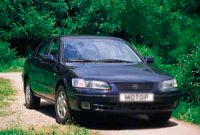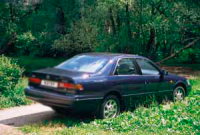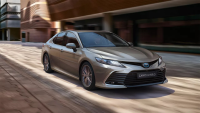To twist a well-known saying: "Tell me what kind of car you have and I'll tell you who you are". And vice versa... The owner of Toyota Camry, for example, is seen as a calm, self-confident person, who does not need extra attention of others. His clothes are conservative, his life is orderly. He doesn't rush anywhere and at the same time he is never late. He knows his job thoroughly, and does it without fuss - reliably and professionally. And, naturally, he expects the same from his car. The main thing is to comfortably and reliably deliver its owner wherever he or she needs to go. Day by day, month by month, year by year...

The expression "American Big Three", habitually meaning Ford, General Motors and Chrysler, is since some time used in one more sense - Ford Taurus, Honda Accord and Toyota Camry. These three models have long been competing for the title of the best-selling car in the US. Last year, the Toyota Camry came out on top...
Why have we started talking about the American market? First, because it is the largest market in the world (385,814 Camrys were sold there last year) and it largely determines the technical policies of manufacturers and the appearance of the cars they produce. Secondly, the Camry is assembled at the plant in Kentucky, and the Americans already consider it an American car.
The Camry acts as the Japanese company's main striking force in the US midsize car sector. Modifications - slightly extended Toyota Avalon and luxury Lexus ES300 will "help" it. Also a coupe - Camry Solara has just appeared.
Certainly, Camry is assembled not only in the USA. The model is so popular, that it is produced also in Malaysia, Australia, RSA... And naturally, in Japan. The Toyota Camry 3.0 V6 with GX package was assembled in Japan.
Appearance of the model from the point of view of modern automobile fashion completely corresponds to what a family sedan of middle class should be. Or the car of a business man. It is especially appreciable when comparing with the previous version made in pseudo-bionic style - with plenty of curvilinear surfaces and smooth lines. The body of the new Camry does not leave a trace of this "riot of forms" - everything is made laconic, simple and, as they say, with taste.
Narrow, stretched in width taillights remind the lighting equipment of some European models. The front end looks powerful and solid.
The interior is in perfect harmony with its exterior. When the door slams shut behind you with a soft click you have a feeling of absolute protection from the outside world. Absolute silence. True, the engine is still not running and the radio is silent, but everything in its time...
Interior is executed with special care - quality of details and their adjustment is above all praises. Plastics trim looks solid, leather upholstery of seats perfectly matched the tone of a foredome and side panels.

The shape of a driver's seat is usual for a middle class car. Electric actuators move the seat horizontally and vertically, as well as tilt the backrest, and they work when the ignition is off. There is a lumbar adjustment knob on the left side of the backrest. There is also electric seat heating. Range of adjustments is quite sufficient, and a steering column - with a changeable angle of inclination. Mutual location of all controls is without remarks. The comfortable steering wheel with a leather covered rim perfectly lies in hands and provides good feedback in the "car-driver" system. An airbag is 'hidden' in the hub.
The standard instrument cluster is covered with the typical Toyota visor, with a clock at the right-hand base. Control switches are made in the traditional Japanese manner - they are used to control almost all electrical devices and mechanisms, including exterior lighting and windshield wipers.
The central console houses "branded music" of Toyota with a removable panel and controls of climate system. Everything is strict and "rectangular". The leather upholstery of the tunnel is occupied by a handle of a selector of a gearbox, reminding the head of the raised cobra. Further the upholstery goes "uphill", forming a support for the central armrest and a place for two cupholders. Here is also the parking brake handle.

The cabin is spacious enough for four tall people. There's room for a third passenger in the rear seat, but they won't like the hard centre section of the seat. Taller rear passengers can be hampered by the sliding sunroof, which protrudes slightly from the ceiling, but there is a "corner of the sky" above their heads - at the upper edge of the rear window. The low-loading boot has good passenger-car capacity, and the split-folding rear seat backrests allow long loads to be carried.
Under the bonnet, a 2995 cc, 190 bhp, 276 Nm V-shaped six-cylinder, 24-valve engine is mounted transversely. The transmission is automatic. (The range also includes 2.2 litre four-cylinder engine and manual five-speed gearbox.) Drive is on the front wheels. Visible upper strut supports indicate that the front suspension is MacPherson. The rear refers to the long-standing and well-proven Toyota design with a spring strut, two transverse links and one longitudinal link.
Turning the key in the ignition The instrument cluster control lamps come to life and go out, the only things left are the overdrive on/off text and the parking brake indicator, green Latin letter P on the gearbox indicator scale. Quiet rustling from under a cowl (conditioner or a fan?) made me look at the dashboard once again - tachometer needle was "glued" to the mark 800 rpm. It turns out, it works! And I was already ready to start the engine again. Toyota always was famous for "quietness" of its power units, but it has surpassed itself this time.
"Handbrake off, selector in D and the car gently moved along without hitting the throttle. The pedal block is well made - "gas" is precisely under a foot resting against the central console; "brake" is precisely in the centre. The left leg rests on its area.

A soft and sensitive accelerator allows exact dosage of tractive effort. The steering wheel is very light, it helps with maneuvering on parking. With gain of speed the feedback increases, but not so much, as we would like it. Though Americans are probably pleased...
Have got out on a motorway, you may give a little more gas. The automobile confidently - within "automatic" limits - gains speed and changes gears, but at first it does it somehow strange. It seems that the transmission is operated by an inexperienced driver - one can feel the moments of switching on and off the clutch and shifting gears, and everything is done somehow inappropriately. I would shift differently...
However, it didn't last long as the confusion suddenly stopped and one had the feeling that there were no "steps" in transmission at all, so smoothly and smoothly the gearbox shifted from one to another. All clear! "The automatic in the Camry is self-learning, with adaptation to the driving style of a particular driver. At the beginning of driving the transmission "got used to" the driver, who instinctively tried to go smoothly. This was exactly what was required. The gearbox 'adjusted' and it went like clockwork. The effect of "mental" control appeared - the habits developed through the years tell me that exactly now it is necessary to shift a gear and it obediently shifts...
Let's try to accelerate sharply. Pedal to the floor, the gearbox "goes down" and Camry quickly picks up speed. When the acceleration stops everything remains the same in the transmission. There's no 'glitch' and the gears shift just as imperceptibly. For city driving it's the right thing to do. The driving intensity can vary - with the same style.
"Changing the style" turned out to be easy enough. We got out to the Moscow Ring Road - to the place where it is wider - and drove sharply, with quick acceleration of engine revolutions. A "learning" period in work of a transmission followed and then everything calmed down and we already had the car ready for high-speed driving on highways - with frequent change of lanes. By the way, here we discovered that there was more wind noise at high speeds than we'd like - the external "aerodynamics" of the body turned out to be deceptive. Nothing is perfect...
Changing lanes is a pleasure, the Camry perfectly obeys the steering wheel and keeps the road in turns and sharp changes. It seems you can just tell the car where to go - it will do the rest. In a city stream it needs only to be directed in the released space and to press gas, it "dives" there as if independently. You can not fear that the box at the most inopportune moment "will decide" to change gear: the exit from the turn confidently accelerate - in accordance with the technique of driving on the front-wheel drive cars. Besides, Camry slows down the engine on descents, and it is peculiar not to all automatics.
Suspension performance in terms of ride smoothness and comfort is highly commendable. It's been a long time since I've had to deal with a car that's equally suitable for fast, manoeuvrable driving on good roads and not afraid of the surface imperfections to which we're so accustomed. Of course, the Camry can't be seen as a panacea for road ills, but as a painkiller it will do just fine. Small irregularities are literally swallowed, you can guess about their existence only by the change of noise of wheels, which can be considered as a consequence of moving from one type of surface to another. When overcoming more serious obstacles the softened suspension gives dull shocks to the body - without perceptible consequences for those inside the car. Bend in corners is within quite acceptable limits. Characteristics of shock-absorbers do not allow developing longitudinal swaying when driving over gentle roughness. Powerful brakes perfectly cope with their work and it seems that ABS is simply not necessary here...
So, Toyota Camry 3.0 V6. It's a good car - there's nothing to say about it. Exactly such a modern car of middle class should be - comfortable, fast and solid. Body of a Camry, possibly, will seem boring. Alright then. Goalkeeper Tretiak was the same "boring". Remember? He did not work for the public, but did his job calmly and professionally - the very reliability and weight .


-rear-and-front-view-camera-6.png)

